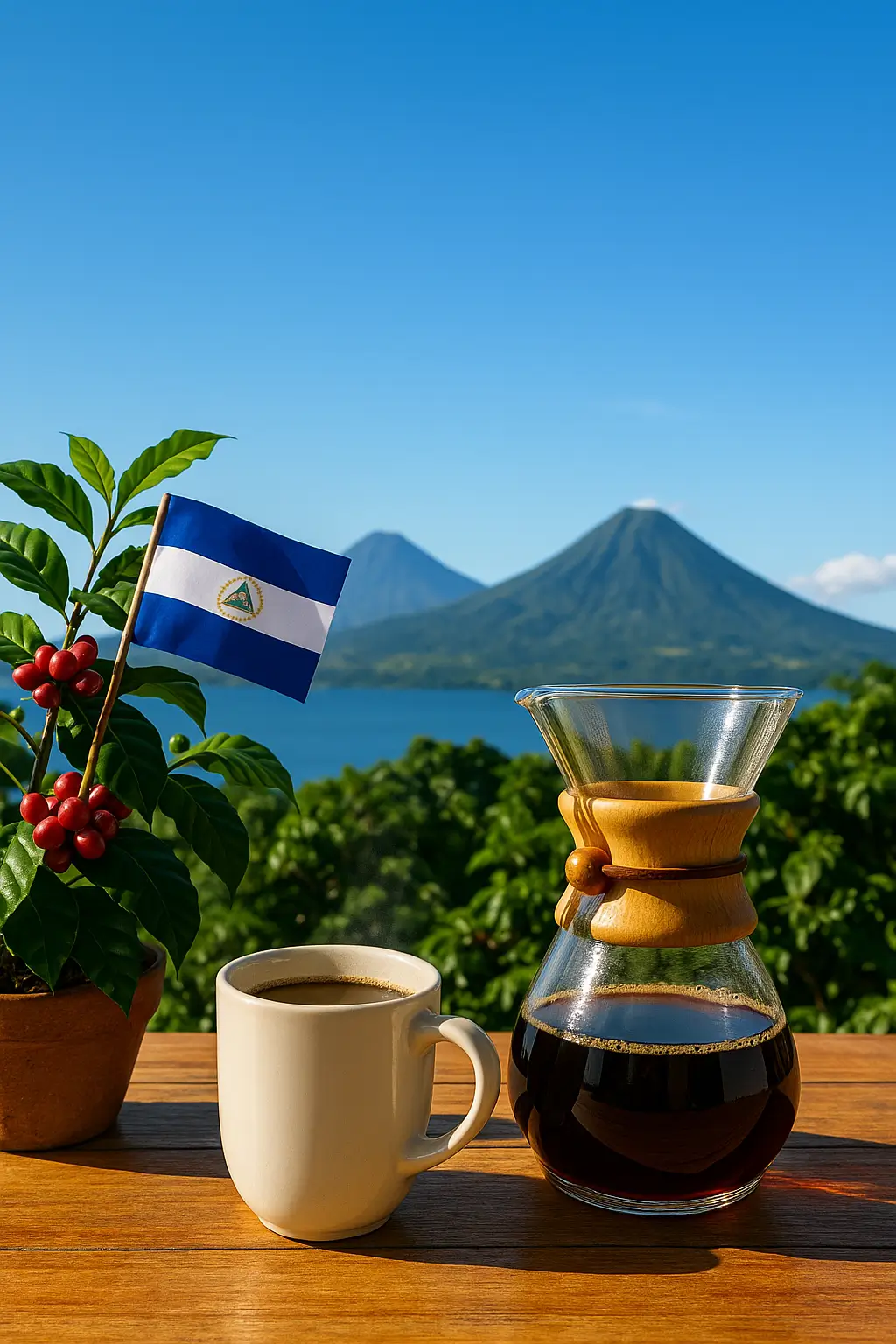Central America offers many fine coffees. Among them, Nicaraguan coffee stands out. It has a distinctive, complex flavor. People worldwide love it. You will learn about Nicaraguan coffee’s unique tastes. Discover its main growing regions. We’ll cover its rich history. Also, explore how growers cultivate and process it. See its economic importance. Understand the industry’s drive for sustainability.
- What makes Nicaraguan coffee unique? The flavor profile
- Journey through Nicaragua’s premier coffee regions
- From bean to cup: cultivation and processing methods
- The rich history and economic impact of Nicaraguan coffee
- Environmental stewardship and quality enhancement
- Sustainability and certifications in Nicaraguan coffee
- Taste Nicaragua’s rich coffee heritage
What makes Nicaraguan coffee unique? The flavor profile
Nicaraguan coffee has a truly unique flavor. It’s balanced and complex. You get bright acidity mixed with sweet, fruity, and nutty notes. These tastes create a nuanced cup. It sets Nicaraguan coffee apart from others in Central America.
Bright, citric acidity and fruity notes
Nicaraguan coffee often shows a bright, lively, clean citric acidity. This acidity brings specific notes:
- Lemon,
- Green apple,
- Berry-like sweetness.
This refreshing taste forms the coffee’s vibrant base. Imagine biting into a crisp green apple. A quality cup of Nicaraguan coffee can taste like that. This refreshing tartness helps give it a clean finish.
Sweet caramel, chocolate, and nutty undertones
Nicaraguan coffee balances its vibrant acidity with a comforting sweetness. Think of caramel. This sweetness blends with rich chocolate and subtle nutty hints. You might taste almond, vanilla, or cocoa. They create a pleasing contrast between sweet and bitter.
These undertones add depth and richness. They make the coffee very approachable. Imagine a delightful mix of sweet treats and dark cocoa. This harmony often shows up in Nicaraguan coffee. These layers unfold as the coffee cools, showing new dimensions of taste.
Body and finish
Nicaraguan coffee typically has a smooth, medium body. It feels good in your mouth. This texture makes for a comfortable, satisfying drink from start to finish. The coffee ends with a clean, balanced aftertaste. It lingers gently on your tongue.
Its medium body means it’s neither too light nor too heavy. You can use it in many brewing methods. This smooth, balanced character makes Nicaraguan coffee enjoyable for many people. It feels both substantial and refreshing.
Journey through Nicaragua’s premier coffee regions
Nicaragua’s main coffee regions give distinct qualities to its coffee. Geography, climate, and soil shape them. Jinotega, Matagalpa, and Nueva Segovia lead the country’s coffee production. Their environments foster varied, complex flavors in Nicaraguan coffee.
| Region | Key Contribution | Elevation | Soil & Climate | Typical Flavor Profile |
|---|---|---|---|---|
| Jinotega | Largest producer (80% of national output) | 1,100 to 1,700 meters | Rich volcanic soil; tropical, shaded climate | Mild with bright citrus and floral notes; fruity and chocolaty undertones; medium body |
| Matagalpa | Significant producer (30% of national output) | Lower altitudes than Jinotega | Rich volcanic soil; tropical climate | Notable fruity and floral profiles |
| Nueva Segovia | Diverse flavor profiles | Varied altitudes | Unique terroir | North: sweet, floral; Central (Las Segovias): richer chocolate and nutty flavors |
Jinotega coffee: the heart of production
Jinotega produces the most coffee in Nicaragua. It provides about 80% of the country’s total. High elevations—1,100 to 1,700 meters—create ideal growing conditions. The region has rich volcanic soil and a shaded, tropical climate. This promotes slow cherry maturation.
Slower development means denser beans and nuanced flavors. Many describe them as mild, with bright citrus and floral notes. Jinotega coffee often shows delightful fruity and chocolaty undertones. These add to its balanced medium body. Growers here ensure a consistently excellent cup.
Characteristics of Matagalpa coffee
Matagalpa also grows a lot of coffee for Nicaragua. It accounts for about 30% of production. This region has rich volcanic soil, usually at lower altitudes than Jinotega. Matagalpa is known for its high-quality Arabica coffee Nicaragua varieties.
Its volcanic soil and tropical climate help Arabica varietals grow with distinct traits. These coffees often have strong fruity and floral profiles. They stand apart. Matagalpa coffee has a reputation for consistent quality and a unique regional taste.
What distinguishes Nueva Segovia coffee?
Nueva Segovia coffee offers diverse flavors. This sets it apart from other Nicaraguan coffee. Coffees from northern Nueva Segovia are known for sweet, floral notes. Central Las Segovias areas tend to produce richer chocolate and nutty flavors.
These unique traits distinguish Nueva Segovia coffee from the common citrus tones in other Nicaraguan regions. Its unique terroir offers a varied and exciting tasting experience. This region continues to surprise coffee fans with its unique offerings.
From bean to cup: cultivation and processing methods
Cultivation and processing methods shape Nicaraguan coffee quality. Small, family-owned farms grow most coffee. They use sustainable techniques. Common processing methods ensure a clear, bright final product.
Key shade-grown Arabica varieties
Small, family-owned farms grow most Nicaraguan coffee. They use shade-grown methods. This protects coffee plants from harsh sun. It also improves soil fertility and biodiversity. Common Arabica coffee Nicaragua varieties include Bourbon, Caturra, and Catuai.
These varietals thrive at high altitudes. This lets coffee cherries mature slowly. Slower growth leads to denser, sweeter beans. They have more complex flavors. Many small cooperatives promote these eco-friendly farming practices.
How the washed process influences Nicaraguan coffee
The washed process coffee Nicaragua method is the most common way to process coffee here. Farmers remove the outer pulp and skin of the cherry. Then, the beans ferment in water. This fermentation breaks down the mucilage sticking to the beans.
After fermentation, workers wash the beans thoroughly. They dry them by sun or machine. This careful process gives Nicaraguan coffee its mild, bright acidity and smooth finish. Regions like Jinotega widely use this method for clear, pure flavor.
The innovative Black Honey process
The specialized Black Honey process is a new drying technique. It’s gaining popularity for Nicaraguan coffee. Most of the fruit’s sticky mucilage stays on the bean during drying. This lets natural sugars deeply penetrate the coffee bean.
The Black Honey process creates unique sweet, honey-like flavors. It also gives a remarkably smooth texture. This method needs careful, daily monitoring. This prevents over-fermentation and ensures great results. It helps produce coffees with distinct sweetness and a luxurious mouthfeel.
The rich history and economic impact of Nicaraguan coffee
Coffee production has deep historical roots in Nicaragua. It still has a major economic impact. Coffee has shaped the nation’s farms, society, and economy for over 150 years. The coffee industry remains a pillar of national wealth.
Historical roots and transformation
The history of Nicaraguan coffee began when Spaniards introduced it in the late 1700s. The first exports happened in 1848. Mass coffee farming started around 1850. It quickly changed Nicaragua’s agriculture and social structure. Coffee became the country’s top export crop.
Policies during the Conservative regime (1857–1892) aggressively expanded coffee plantations. This often came at a high human cost. This expansion included seizing indigenous Cacaopera lands and violently suppressing local uprisings. Over time, coffee growing moved north. It became deeply rooted in rural economies and land use.
Nicaraguan coffee: an economic pillar and global player
Coffee is a main export for Nicaragua. It brings in about 30% of agricultural export earnings. The coffee sector employs over 330,000 people. This makes it a vital income source for rural communities. They rely on seasonal harvest work. This industry truly supports the national economy.
Nicaragua is the 12th largest coffee producer globally. 98% of its production is Arabica coffee. This Arabica is known for its diverse, complex flavors. Nicaragua’s volcanic soil and microclimates largely cause this. Even with political unrest and economic challenges, the coffee industry stays strong. It remains central to Nicaragua’s economy and culture.
Environmental stewardship and quality enhancement
Environmental factors and smart farming practices truly shape Nicaraguan coffee quality. They give the beans their unique traits. Think density, sweetness, or complex flavors. The natural environment is key to coffee excellence.
How altitude and climate influence quality
Higher altitudes greatly improve Nicaraguan coffee quality. Coffee grown above 1,200 meters qualifies as Strictly High Grown (SHG). Cooler temperatures at these heights make coffee cherries mature slowly.
This slow development yields denser, sweeter beans. They have more complex flavors and higher acidity. High-altitude coffees—especially from northern regions like Jinotega and Matagalpa—are favorites in tasting panels. They have clean, lively profiles. They always show vibrant acidity and pleasant fruity and floral notes.
The combination of high altitude and fertile volcanic soil gives Nicaraguan coffee its distinct, complex character. This mix allows sugars and acids to develop slowly, leading to an incredibly balanced and nuanced cup.
Impact of regional terroir on flavor diversity
Different regional soil types and microclimates create diverse flavor profiles in Nicaraguan coffee. Jinotega’s volcanic soil and tropical climate, for example, lead to well-balanced coffee. You’ll find notes of chocolate, nuts, fruits, and citrus. But central regions like Nueva Segovia produce coffee with deeper chocolate and nutty flavors.
These differences show how terroir directly affects the final cup. It offers a wide range of tastes. Northern high-altitude zones typically produce coffees rich in acidity, with low bitterness. The unique blend of environment and varietal makes for a truly distinctive coffee experience.
Nicaraguan coffee adapting to environmental stresses
Nicaraguan coffee faces challenges from environmental stresses. These include water availability, sunlight, and temperature changes. Climate change, for instance, risks reducing acidity and flavor complexity in lower-altitude areas. Managing these factors helps maintain quality.
Producers use strategies to lessen these impacts. This includes extra irrigation or specific farming adjustments. Such measures help keep the coffee’s flavor profile intact. Adapting to these environmental shifts is vital for the long-term health and quality of Nicaraguan coffee.
Sustainability and certifications in Nicaraguan coffee
The coffee sustainability Nicaragua movement is growing fast. Producers are adopting new practices and seeking certifications. These efforts protect the environment, ensure economic viability, and boost social fairness. The industry is committed to growing responsibly.
Key sustainability practices
Nicaraguan coffee producers use several key sustainability practices. They aim to protect the environment and farm responsibly. Many use organic farming, avoiding harmful chemicals. Many farms also grow coffee under shade trees.
Shade-grown methods boost biodiversity. They protect fragile ecosystems and improve soil fertility. Farmers also save water during processing. Responsible waste management handles byproduct in an eco-friendly way. This helps the land stay healthy long-term.
Certifications and support driving change
Various certifications help promote sustainable practices. They also support small farmers in the Nicaraguan coffee sector. Organic certification, for instance, needs a three-year transition. It’s good, but its cost and complexity often require help from cooperatives and development groups for small farmers.
Other important certifications include:
- C.A.F.E. Practices certification: This focuses on sustainable farming and economic viability throughout the coffee supply chain,
- Rainforest Alliance certification: It highlights environmental and social sustainability. It often boosts farmer incomes with targeted investments in sustainable practices,
- Fair Trade certification: This helps small farmers access global markets. It promotes better livelihoods through fair pricing and community development premiums.
These certifications demand strict adherence to rules. These cover agrochemical use, water source protection, and biodiversity. Small farmers often need outside financial and technical help to get and keep these certifications. This shows why teamwork is important for advancing coffee sustainability Nicaragua. For example, Finca Idealista shows integrated sustainability. They combine rainforest conservation with new, low-impact farming. This helps preserve local ecosystems and improves coffee quality.
Taste Nicaragua’s rich coffee heritage
Nicaraguan coffee offers an exceptional flavor. It has bright acidity, balanced with sweet caramel, chocolate, and nutty notes. Its journey starts on dedicated farms in Jinotega, Matagalpa, and Nueva Segovia. High altitude, volcanic soil, and shade-grown methods create its complex flavors.
The rich history of Nicaraguan coffee shows its deep economic importance. It supports hundreds of thousands of lives. It significantly contributes to the national economy. The industry also strongly commits to coffee sustainability Nicaragua. Practices like organic farming and certifications—like Fair Trade—prove its dedication to the environment and social responsibility.
Go ahead, find and try Nicaraguan coffee. Experience its unique qualities. Support the sustainable practices that make it a truly remarkable drink.









